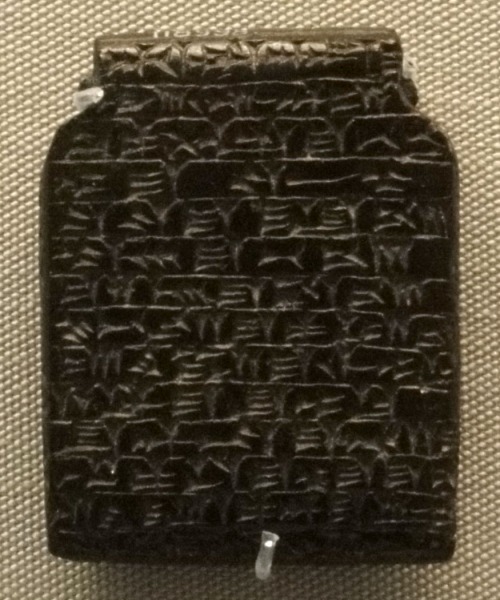Kvanvig: The mīs pî and pīt pî Rituals of Mouth Washing and Mouth Opening
by Estéban Trujillo de Gutiérrez
“The āšipū did not only expel demons; they had one more important duty that they performed together with other specialists, the bārû, “haruspex / diviner” and the kalû, “lamentation chanter.”
They had the primary responsibility for consecration of the divine statue. In this duty they performed ina šipir apkalli, according to the “task” or “office” of the apkallu, apkallu (singular) here to be understood either as a general reference to the transcendent beings, or as R. Borger claims, as a concrete reference to the apkallu par excellence, Adapa.
The material form of the statue was animated in the way that the statue did not only stand for the represented god, but manifested this god.
(R. Borger, Die Inschriften Asarhaddons. Königs von Assyrien, vol. 9, Afo. Graz, 1956, p. 89. Cf. C. Walker and M. Dick, The Induction of the Cult Image in Ancient Mesopotamia, vol. 1, SAALT, Helsinki, 2001, pp. 4-19.)
The ritual had two stages, the mīs pî, “mouth washing,” and the pīt pî, “mouth opening.” The “washing of the mouth” purified the cult image from any human contamination; the “opening of the mouth” enabled the statue to function as a deity.

This is a photograph of Tablet IV of the Poem of Erra. The tablet is dated to 629-539 BCE.
https://tourguidegirl.files.wordpress.com/2014/11/img_0744.jpg
The ritual was performed by consecrating a new or restored statue. The dwelling of the god in his statue was necessary to secure cosmic stability. If a god left his image, chaos broke loose. This is clearly illustrated in the Poem of Erra.

Black stone amulet against plague.
A quotation from the Akkadian Epic of Erra.
BM 118998, British Museum, Room 55.
Registration: 1928,0116.1.
Photo by Fae.
This file is licensed under the Creative Commons Attribution-Share Alike 3.0 Unported license.
You are free to share – to copy, distribute and transmit the work, to remix – to adapt the work, under the following conditions:
Attribution – You must attribute the work in the manner specified by the author or licensor (but not in any way that suggests that they endorse you or your use of the work).
Share alike – If you alter, transform, or build upon this work, you may distribute the resulting work only under the same or similar license to this one.
https://commons.wikimedia.org/wiki/File:Amulet_to_ward_off_plague.jpg
The poem draws a clear parallel between the chaotic state of humankind and the poor condition of the statue of Marduk. The god Erra who aspires to take over lordship from Marduk approaches him:
“Why has your precious image, symbol of your lordship,
Which was full of splendor as the stars of heaven,
Lost its brilliance?
Your lordly diadem, which made the inner sanctum shine
Like the outside tower, (why is it) dimmed?”
(Poem of Erra I, 126-7. Translation according to Foster, Before the Muses, p. 887.)
Marduk explains that he once rose from his dwelling and sent the flood with the result that chaos prevailed. His divine statue was reshaped after the flood and he entered lordship again (I, 140-4). When this was done, he sent away the primeval ummanus, who clearly was in charge of the reshaping:
“I made those ummanus go down to the apsû,
and I said they were not to come back up.”
(Poem of Erra I, 147).
Since then his statue had decayed. The ummanus, this time called sebet apkal apsî, “the seven apkallus of the apsû,” were no longer present to take care of his image:
“Where are the Seven apkallus of the apsû, the holy carp
who are perfect in lofty wisdom like Ea’s, their lord,
who can make my body holy?”
(Poem of Erra I, 162).

Entry on Girra, or Gerra, as Kvanvig prefers, from J. Black & A. Green, Gods, Demons and Symbols of Ancient Mesopotamia, p. 88.
Consequently Erra persuades Marduk to leave his statue and lordship, and hand the power over to him until Marduk’s statue is restored:
“Prince Marduk, until you reenter that house
and Gerra cleanses your robes,
and you return to your place,
until then I shall rule and keep firm control of heaven and earth”
(Poem of Erra I, 180).
Marduk leaves his statue. This is commented by Ea in a passage with several interesting features (Tablet II):
“Now, the prince Marduk has arisen,
he has not commanded those ummanus to come up.
How can their images, which I created among the people,
approach his sublime divinity, where even a god cannot enter?
To those ummanus he gave a broad heart …”
(F.N.H. Al-Rawi and J.A. Black, “The Second Tablet of “Ishum and Erra,” Iraq 51, 1989, pp. 111-22, 114.)”
Helge Kvanvig, Primeval History: Babylonian, Biblical, and Enochic: An Intertextual Reading, Brill, 2011, pp. 136-7.

[…] are performed to open the eyes, ears and nose of the image. The whole ritual of the mis pi then symbolizes infusing the image with the life of the deity so that the image can now represent the deity during […]
LikeLike